33 Keys to Decoding the Korean Wave #21 K-Golf : Queens of the Greens, The Goddess of Golf
33 Keys to Decoding the Korean Wave #21 K-Golf
#21 Queens of the Greens, The Goddess of Golf
*한류를 이해하는 33가지 코드 #21 그린의 여왕들, 골프의 여신들 <Korean version>
https://www.nyculturebeat.com/index.php?mid=Focus&document_srl=4082766
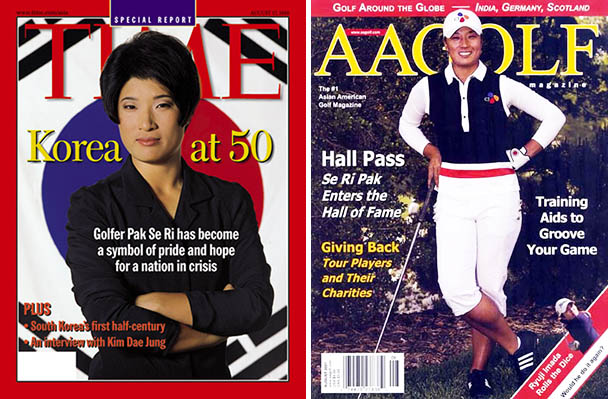
Se Ri Pak appeared on the cover of the weekly “Time” magazine in 1998 (left) / In 2007, she was inducted into the LPGA Hall of Fame and graced the cover of “Asian American Golf” magazine.
-South Korean women have golf down to a tee <Telegraph, 2019>
-K-golf: South Korea’s female golfing phenomenon <BBC, 2017>
-South Korea’s golfing women: “You’re either a champion, or nothing” <CNN, 2016>
-South Korean queens of greens rule women’s golf <AFP>
-Why Korea Makes The World’s Best Women Golfers <Wall Street Journal, 2007>
-South Korea Becomes New Face of L.P.G.A. <New York Times, 2006>
In 1998, 20-year-old Se Ri Pak took the golf world by storm, earning the title of “Queen of Golf” by winning four tournaments in a single season, including the US Women’s Open and LPGA Championship. Over the past two decades, women’s golf has been dominated by a generation of golfers inspired by Se Ri Pak, affectionately known as "Se Ri’s Kids."
Se Ri Pak is a legend in Korean golf, a national hero who gave hope to the people during the financial crisis (IMF crisis) of the late 1990s. Just four months after her LPGA debut in 1998, she clinched victories at the McDonald’s LPGA Championship and the U.S. Women’s Open Championship. Her first season was marked by four wins, including the Jamie Farr Kroger Classic and the Giant Eagle LPGA Classic, earning her the title of Rookie of the Year. Pak’s tenacity and “barefoot fighting spirit” propelled her to a total of 25 wins on the LPGA Tour and 39 wins in her career. In 2007, she became the first and youngest Asian player inducted into the World Golf Hall of Fame.
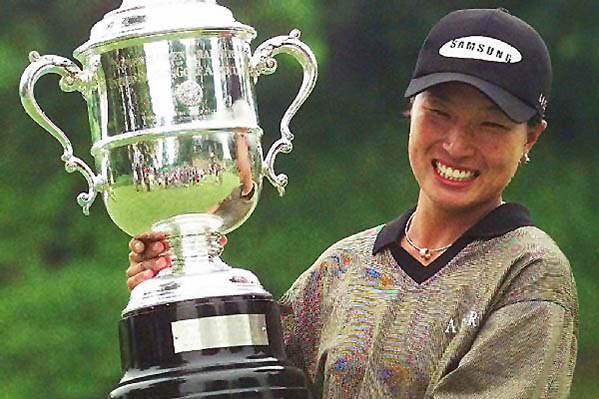
Se Ri Pak won the US Women’s Golf Championship on July 7, 1998. Photo: USGA
The success of Se Ri Pak inspired a wave of talented golfers like Mi-Hyun Kim, Grace Park, Hee-won Han, and a group of rising stars known as the “Se Ri Kids.” This group includes Jiyai Shin, Inbee Park, Na Yeon Choi, So Yeon Ryu, Sung-hyun Park, Jin-young Ko, and Jeong-eun Lee6, all of whom have triumphed at the LPGA or U.S. Women’s Open championships. The abundance of similarly named players in the KLPGA, such as Jeong-eun Lee6 and Min-ji Kim6, reflects the sheer number of talented golfers from Korea.
Inbee Park, who turned professional in 2012, has won seven major tournaments, including two US Open titles (2008, 2013) and the PGA Championship (2013, 2014, 2015), as well as a gold medal at the 2016 Rio Olympics, achieving the “Career Grand Slam.” She became the youngest person to be inducted into the LPGA Tour Hall of Fame, following Se Ri Pak in 2016.
Even amid the slowdown in global sports due to the COVID-19 pandemic, Korean golfers continued to excel. In June 2022, Korean-Australian Minjee Lee won the U.S. Women’s Open at Pine Needles, North Carolina. Second place went to Mina Harigae (USA), third to Hye-jin Choi (South Korea), fourth to Jin-young Ko (South Korea), and fifth to Korean New Zealander Lydia Ko. Korean players occupied four of the top five positions. Later that month, In Gee Chun won the KPMG Women’s PGA Championship, the third major tournament of the LPGA Tour season, held in Bethesda, Maryland.
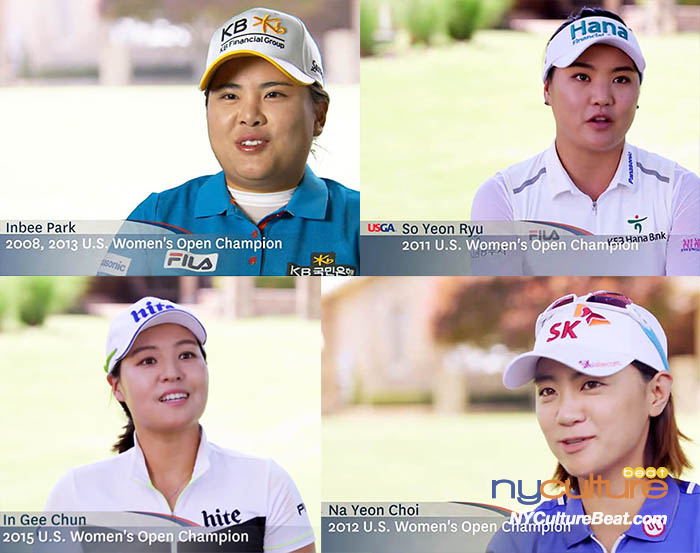
Inbee Park (clockwise from top left), who is said to have been inspired by Pak to become a golfer, So Yeon Ryu, Na Yeon Choi, and In Gee Chun, all became US Open champions. Photo: USGA *Se Ri Pak: Inspiring a Generation, USGA <YouTube>
Since Se Ri Pak’s historic win at the US Open in 1998, ten Korean golfers have claimed the Champion Cup at the US Open up until 2019, including Birdie Kim (Mi-Hyun Kim, 2005), Inbee Park (2008, 2013), Eun-hee Ji (2009), Na Yeon Choi (2012), Michelle Wie (Seong-mi Wie, 2014), In Gee Chun (2015), Sung-hyun Park (2014, 2017), and Jeong-eun Lee6 (2019).
In the early 2000s, as more Korean players began dominating the LPGA Women’s Open, U.S. media even dubbed it the “US Korea Open.” In August 2008, the LPGA sparked controversy by introducing a rule requiring players to pass an English proficiency test starting in 2009. At the time, 45 of the 121 international players on the LPGA Tour were from Korea. The men’s PGA Tour, however, did not impose any such regulation. The LPGA’s rule, perceived as targeting the increasing success of Korean female players, was widely criticized as racist and hypocritical, leading to its repeal after just two weeks.
LPGA Commissioner Carolyn Bivens, who championed the mandatory English regulation, faced backlash from the U.S. media and domestic and international players. She resigned in July 2009, with two years remaining in her term, and was replaced by Michael Whan, who served as LPGA Commissioner until May 2021.
The extraordinary success of Korean women golfers has transformed the global landscape of the sport. They have not only set new standards in the game but have also broken cultural and linguistic barriers, proving that talent and determination know no bounds.
U.S. Women’s Open Champions
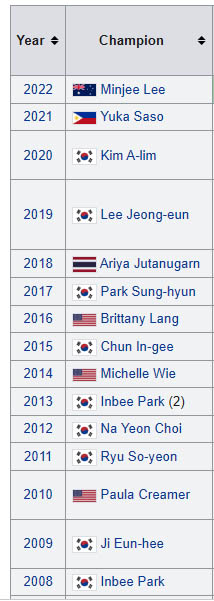
Wikipedia
Seven Secrets to Korea’s Dominance of Women’s Golf
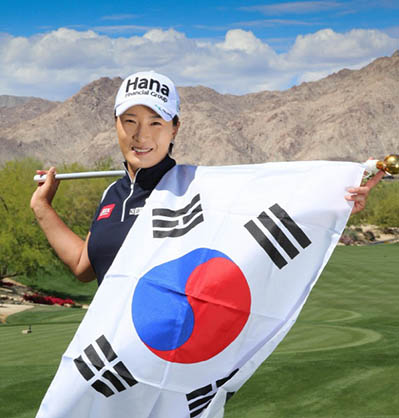
Se Ri Pak
The global media, including outlets like The New York Times, Wall Street Journal, CNN, BBC, Telegraph, and AFP, have shown immense interest in uncovering the secrets behind the phenomenal success of Korean female golfers. Even former U.S. President Donald Trump, an avid golfer himself, was curious. During his visit to Korea in June 2019, he met Se Ri Pak, head coach of the women’s golf team, at the Korea-U.S. leaders’ dinner at the Blue House. Trump reportedly asked Pak, “Why are American players not as good as Korean players?” and suggested they play a round of golf together.
In his 2019 article “Secrets to South Korea’s Dominance of Women’s Golf” for Women’s Golf, Ben Harpring explored this phenomenon: “So what are the secrets to Korea’s consistently amazing success in women’s golf? There must be something unique that separates a country the size of Indiana geographically, with a population roughly 16% that of the United States, from the rest of the golf world.” Harpring concluded that Korea’s success comes down to two primary factors: the country’s unparalleled professional golf development program and the inspiration provided by three iconic players—Se Ri Pak, Jiyai Shin, and So Yeon Ryu—who have shown young Korean girls what is possible.

“Se-ri Kid” Inbee Park achieved golf’s Gold Grand Slam with seven major wins and a gold medal at the Rio Olympics, and she was inducted into the LPGA Hall of Fame in 2016.
Annika Sörenstam, often referred to as the “Empress of Golf,” echoed similar sentiments during a press conference on her visit to Korea in 2009. She remarked, “They [Korean golfers] are very, very solid. Consistency, great technique, and an incredible work ethic are three elements that make them successful. Other players are learning from the Koreans.”
In a 2015 interview with Financial News Korea, Inbee Park, a prominent figure in women’s golf, added, “Compared to other sports, golf relies more on mental strength and natural talent than physical attributes. In that respect, Korean players seem to have a strong will and a natural sense for the game. Additionally, the commitment and sacrifice that Korean parents make for their children’s education and development surpass that of parents from many other countries.”
#1. Mental Fortitude: 80% of the Game
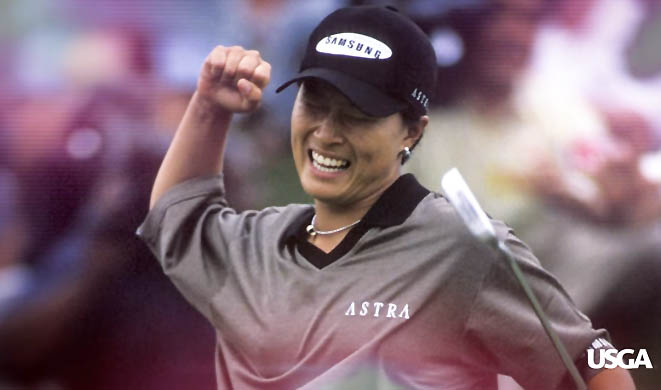
Se Ri Pak’s moment of victory at the 1998 US Women’s Open. Photo: USGA
Eighteen-time major champion Jack Nicklaus once said, “Golf is 80% mental, 10% ability, and 10% luck.” For Korean golfers, this mental strength is arguably their greatest asset. Throughout history, the Korean people have endured war, colonial rule, division, dictatorship, and poverty, yet they have emerged as a thriving, economically advanced nation. This resilience is fueled by patience, a relentless spirit, determination, and an indomitable fighting spirit—qualities that manifest as fierce grit and perseverance.
Korean women, inheriting this DNA of endurance, build their mental strength through rigorous self-discipline, practicing to the brink of exhaustion in the highly competitive world of sports. Unlike many international female players who often take up golf as a leisurely activity, Korean players pursue the sport with unwavering commitment, driven by a clear goal of achieving professional success. In this context, mental power—comprising persistence, tenacity, courage, calmness, focus, and resilience—becomes a secret weapon, allowing them to overcome physical limitations and adverse conditions. This strong mentality is a form of tenacity that sets Koreans apart.
So Yeon Ryu, the 2011 U.S. Women’s Open champion, shared in a 2015 interview with Financial News Korea: “Korean players’ ability to control their emotions is what makes them the best in the world. Even if they get angry, they manage it well. This emotional control is unparalleled compared to players from other countries, and because golf is such a mental game, it provides a significant advantage.”
David Leadbetter, who has coached legends like Greg Norman, Se Ri Pak, and Michelle Wie, echoed this sentiment: “Korean players focus solely on their goals. Their mental strength is formidable. It’s this unwavering focus and fierce determination that has elevated Korean golf to its current heights.”
Brian Mogg, a PGA coach who runs a golf academy in Seoul, told CNN, Brian Mogg, a PGA coach who runs a golf academy in Seoul, told CNN, "Koreans are the most disciplined people on earth... You tell them to do something but they don't just do it, they do it to the nth degree, and they do it hard and passionate."
#2. Role Model and Game Changer: Se Ri Pak
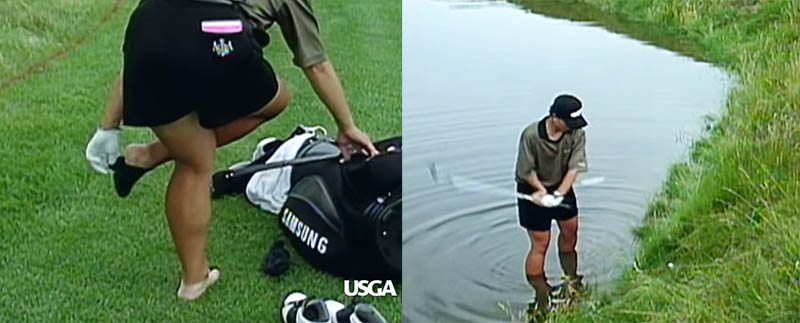
Se Ri Pak in the US Women’s Open playoff in July 1998.
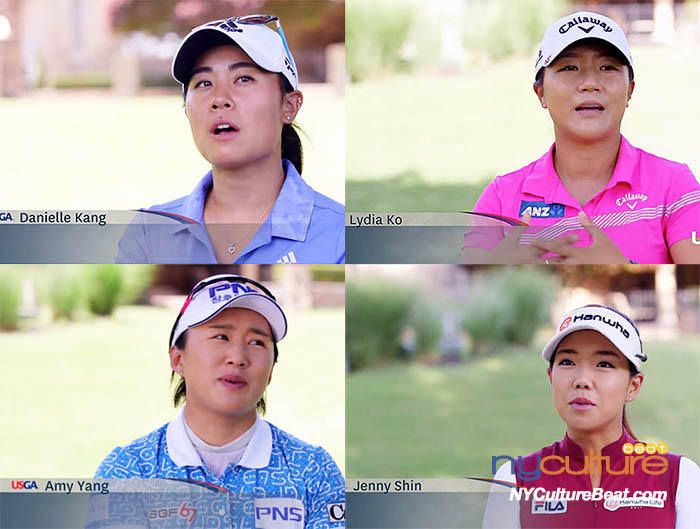 Se Ri’s Kids started playing golf with Se Ri Pak as their role model. Danielle Kang, Lydia Ko, Jenny Shin (Shin Ji-eun Shin), Amy Yang (Hee-Young Yang). Photo: USGA *Se Ri Pak: Inspiring a Generation, USGA <YouTube>
Se Ri’s Kids started playing golf with Se Ri Pak as their role model. Danielle Kang, Lydia Ko, Jenny Shin (Shin Ji-eun Shin), Amy Yang (Hee-Young Yang). Photo: USGA *Se Ri Pak: Inspiring a Generation, USGA <YouTube>
3. The “Golf Daddy” and the “Good Daughter” Complex
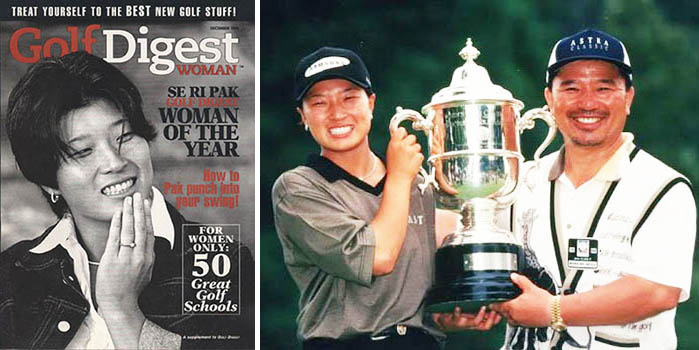
Se Ri Pak (left) on the cover of Golf Digest magazine. Se Ri Pak and her father, Joon Chul Pak, holding the 1998 U.S. Women’s Open championship trophy.
In the United States, there are "Tiger Moms" who push their children to excel, and "Soccer Moms" who support their kids’ athletic endeavors. In Korea, there is a unique phenomenon known as the “Golf Daddy”—fathers who dedicate themselves entirely to nurturing their daughters’ golf careers.
Behind Se Ri Pak’s success story lies the unwavering support of her father, Joon Chul Pak, a quintessential “Golf Daddy.” Many other top Korean golfers, including Inbee Park, Jiyai Shin, Mi-Hyun Kim, Na Yeon Choi, Birdie Kim (Ju-Yun Kim), Sung-hyun Park, Lydia Ko, Hyo-Joo Kim, Chella Choi, and Ha-na Jang, have also benefited from their fathers’ dedication and sacrifice. These families embody a strong sense of loyalty and filial piety, virtues deeply rooted in Confucian society. For these athletes, competing on the world stage is not just about personal achievement; it is also a matter of family honor and national pride.
The New York Times has highlighted the significant role passionate parents play in the success of Korean players on the LPGA Tour. In a July 1998 article titled “GOLF: Raised To Be A Champion; Father’s Firm Push Sent Pak To the Top of Women’s Golf,” the newspaper focused on the tenacity of Joon Chul Pak, who believed in his daughter’s potential from a young age.
At the time, golf in Korea was considered a sport for the wealthy, with annual country club memberships costing between $200,000 and $1 million. Se Ri Pak’s family, however, did not belong to this elite class. In her second year of middle school, Se Ri participated in the Golf Digest Cup tournament in Yeoju. During the event, Joon Chul Pak introduced himself to the parents of other young golfers, but he was ignored due to his lower social status.
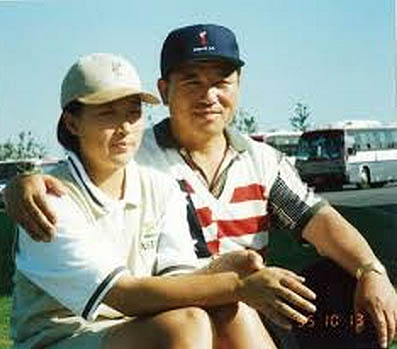
1996 Se Ri Pak and “Golf Daddy” Joon Chul Pak
In an interview with New York Times reporter Ira Berkow, Mr. Pak recalled, “They completely ignored me. I suppose my daughter and I didn’t seem significant to them because of their high social standing. So I called Se Ri over to the trophy display and handed one to her, saying, ‘This is yours.’ The others looked at me like I was a lunatic. I shouted back, ‘So what if I touch it? My Se Ri is going to take it home with her anyway!’ Se Ri nodded in agreement. And later, she did take the trophy home.”
That trophy was just the beginning. Se Ri Pak went on to excel both as an amateur and a professional in Korea, and at the age of 20, she burst onto the world stage. In her rookie year on the LPGA Tour in 1998, she won four tournaments, including the McDonald’s LPGA Championship, U.S. Women’s Open, Giant Eagle LPGA Classic, and Jamie Farr Kroger Classic, fulfilling her father’s bold prediction.
The New York Times also noted Mr. Pak’s harsh, Spartan training methods. He was known to reprimand his teenage daughter severely if she did not follow his golf instructions. He made her practice daily at Daejeon’s golf course, regardless of the weather—whether in the sweltering heat or the biting cold, sometimes with icicles forming in her hair. He even camped with her in a tent next to a cemetery and left her alone in the dark to build her courage. People in the neighborhood thought Joon Chul Pak was crazy, and even his wife worried he might push their daughter too far—all for a sport that was not widely popular in Korea at the time. But Mr. Pak believed in Se Ri’s talent and perseverance, convinced that she had what it took to become one of the world’s greatest players. His faith was vindicated when she became a global golf sensation.
The “Golf Daddy” phenomenon in Korea highlights the intense dedication and sacrifice that these families make, driven by a belief in their daughters’ potential to succeed on the world stage. It is a story of relentless ambition, fierce love, and the unyielding pursuit of a dream that has redefined women’s golf in Korea and beyond.
4. Early Education: Cultivating the Next Generation of Golf Champions

Magazines featuring Michelle Wie (Sung-mi Wie), a Korean American golf prodigy from Hawaii, on the cover.
Tiger Woods played on the golf course at a young age thanks to his father, who was an amateur golfer. At the age of two, he competed in a putting contest against comedian Bob Hope on TV’s “The Mike Douglas Show,” and at the age of three, he was a golf prodigy who shot 48 in nine holes at the Navy Golf Course. Michelle Wie, a gifted girl from Hawaii, started picking up a golf club when she was 4, and by the time she was 10, she was competing in the U.S. Women’s Amateur Public Links Championship. In 2003, when she was 13, she competed in the Kraft Nabisco Championship (now ANA Inspiration) and the US Women’s Open.
Golf was once a noble sport in Korea. Ok-hee Ku and K. J. Choi (Choi Kyung-Ju) worked as caddies before becoming successful professional golfers. Se Ri Pak may be the first case of success through early education. The first time she picked up a golf club was in the 6th grade of elementary school, and in the 2nd grade of middle school, she began learning in earnest on the golf course. In elementary school, she was a track and field athlete, building her basic physical strength by competing in the shot put, broad jump, and 100-meter run, before going all-in on golf.
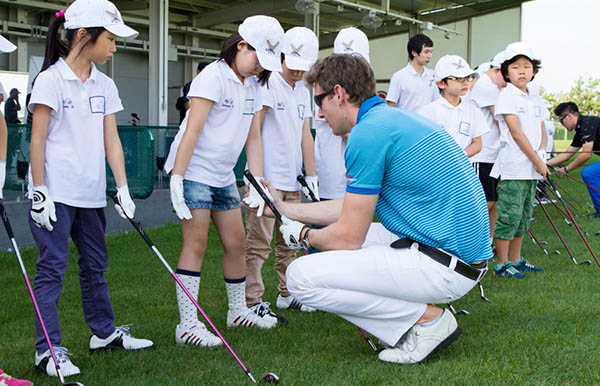
Photo: Callaway Golf https://www.callawaygolfkorea.co.kr
The earlier the education, the better. After Se Ri Pak’s sensation, there was a boom in early golf education in Korea. Numerous young Se Ri wannabes flocked to the golf driving range. Junior golf education costs a lot of money, including lesson fees, greens fees, competition participation fees, and field training fees. This is an investment made by golf dads who want to develop their children’s talents.
The more competitions the better. Se Ri Pak, Mi-Hyun Kim, and Hee-won Han developed their skills in student golf competitions. There are about 10 golf tournaments hosted by the Korea Middle and High School Golf Association (KJGA). It is important for golf prospects to gain as much experience as possible.
An early study abroad group also emerged. Grace Park moved to the United States in elementary school, Inbee Park went to study golf in middle school, and Lydia Ko went to New Zealand to study golf when she was 6 years old. This is also because it is advantageous to adapt to the local environment from a young age in order to participate in the LPGA.
Meanwhile, the KPLGA conducts youth programs, kids’ golf teams, golf driving range support, and golf clinics, and started the KLPGA Samchully Dream Tree Competition in 2015 to nurture girl golfers.
With the continued success of female golfers following Se Ri Pak, and golf being adopted as an official sport at the 2016 Rio Olympics, the number of junior golfers has increased rapidly, and the number of golf academies that serve as a gateway to becoming a professional has also mushroomed.
The commitment to early education and structured training has not only nurtured individual talent but has also solidified Korea’s position as a powerhouse in women’s golf on the global stage. These young golfers, backed by their families and supported by a growing infrastructure, are proving that with the right start, the sky is the limit.
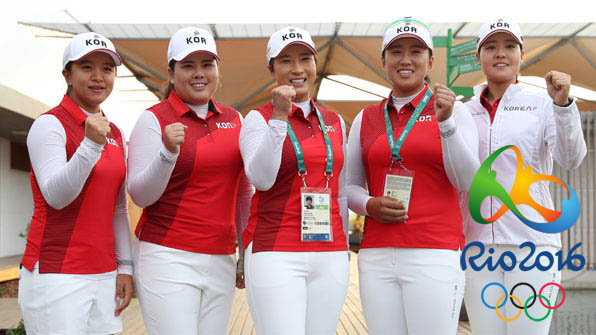
Coach Se Ri Pak (center), Sei-young Kim (from left), Inbee Park, Amy Yang, and In-gee Chun at the 2016 Rio de Janeiro Olympics, where golf was adopted as an official sport. Inbee Park won a gold medal at the 2016 Rio Olympics.
For junior golfers in Korea who aspire to become world-class professionals, being selected for the national team is a crucial milestone. This elite team has produced some of the finest golfers, including LPGA champions such as Se Ri Pak, Mi-Hyun Kim, Hee-won Han, Soo-yun Kang, Jiyai Shin, Na Yeon Choi, So Yeon Ryu, Hyo-joo Kim, Ha-na Jang, In-gee Chun, and Jin-young Ko. Most of these players, with the exception of those who pursued their training abroad, honed their skills as part of the national team, proudly representing the Taegeuk flag.
To qualify for the national team, young golfers must accumulate points by participating in junior competitions and demonstrating consistent excellence. Once selected, they undergo rigorous training that includes over 150 days of annual training camps and participation in high-level course competitions. This Spartan-style regimen provides them with a wealth of practical experience before they even step onto the world stage.
Representing Korea not only alleviates the financial burden for these players but also propels their careers by providing opportunities to compete in international tournaments. As a result, participation in gifted education programs, junior competitions, and the national team becomes a well-established pathway to success on the LPGA Tour.
In contrast, the United States lacks a structured national team system for golf, which often results in financial instability for many individual players. The Korean model, with its emphasis on early identification and support of talented players, creates a more stable and effective development pipeline, producing champions who are well-prepared for the rigors of professional golf.
6. The KLPGA: A Stepping Stone to Global Success
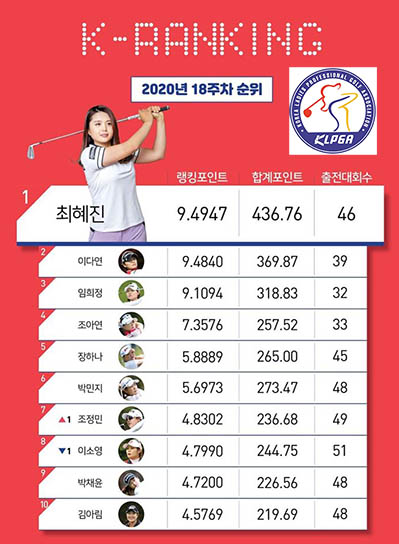
KLPGA player rankings (2020. 18th week)
Experience on the Korea Ladies Professional Golf Association (KLPGA) tour is another key factor in the success of Korean golfers on the international stage. The KLPGA provides an essential training ground where players can build their skills, gain professional experience, and strengthen their competitiveness before advancing to the LPGA or U.S. Open.
In 2019 alone, the KLPGA hosted 31 tournaments, offering a robust platform for players to develop their games under real-world conditions. By the time Korean golfers debut in American competitions, they have already honed their abilities and mental toughness through the rigorous KLPGA tour. While they may be considered rookies in the U.S., they often arrive with the experience and poise of seasoned champions.
The KLPGA Tour has grown into one of the premier women's golf tours globally, alongside the LPGA in the United States and the JLPGA in Japan. Its origins were humble, beginning in 1978 at the Royal Golf Course in Yangju, Gyeonggi-do (now Lakewood Golf Course), with the first women’s professional golf test. Eight pioneers, including Kang Chunja, Han Myeonghyun, Ok-hee Ku, and Ahn Jonghyun, took part in this initial event. The first official KLPGA tour was held in 1988, coinciding with the Seoul Olympics, a time when the sports boom was at its peak. The late Ok-hee Ku’s victory at the 1988 LPGA/Standard Register Classic marked a historic moment, creating a new legend in women's golf.
The international success of Se Ri Pak in 1998 was a turning point, spurring rapid growth and expansion of the KLPGA tour, including tournaments in China and Vietnam. Inspired by Pak, a generation of young, aspiring golfers emerged, rapidly advancing through the ranks.
With its strong developmental infrastructure, early exposure to high-level competition, and a nurturing environment that supports players from a young age, the KLPGA has become a critical stepping stone for Korean golfers on their way to achieving global success. As a result, Korean players continue to dominate women’s golf, showcasing a level of talent and determination that sets them apart on the world stage.
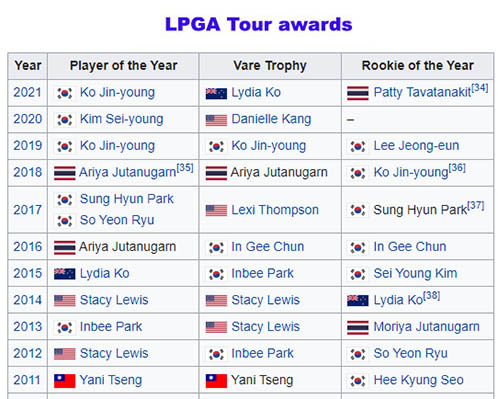
Wikipedia https://en.wikipedia.org/wiki/LPGA
7. Corporate Sponsorship: Fueling Success and Changing Lives

Synergy effect between Korean female golfers and companies. Se Ri Pak’s sponsors changed to Samsung, CJ, KDB Group, and Hana Bank.
In a March 2020 article titled “Women’s golf embraces South Korean dominance as a positive force in Asia and worldwide,” SportsBusiness highlighted the crucial role of corporate sponsorship in the success of Korean female golfers. Historically, prize money for golf tournaments was modest, but with the entry of large Korean companies as sponsors, the stakes have risen significantly.
This surge in sponsorship has not only enhanced prize purses but has also attracted international companies eager to tap into the burgeoning Asian market. Sponsoring companies are eager to back outstanding players, and each golf tournament now boasts its own corporate sponsor. LPGA Commissioner Mike Whan noted that the success of Asian players has broadened business opportunities abroad and that viewership of the LPGA Tour is particularly high in Korea and Japan.
In professional sports, prize money and sponsorship deals are the ultimate indicators of success. Se Ri Pak paved the way for future generations by signing a lucrative 10-year contract with Samsung in 1996 and later moving to CJ in 2002. For Se Ri’s Kids—aspiring young golfers inspired by her achievements—this marked a paradigm shift. Rather than striving solely for academic success or dreaming of celebrity status, they saw golf as a viable path to wealth and fame.
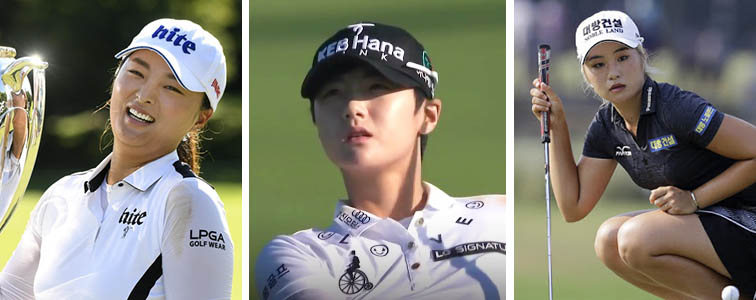
Jin-young Ko, Sung-hyun Park, Jeong-eun Lee6.
Golf marketing has become a goldmine for businesses, as players serve as “walking billboards” for their sponsors. The marketing potential is immense, with opportunities to boost brand visibility, enhance corporate image, and target high-income VIP customers. The LPGA Tour, in particular, offers companies a unique platform to market their brands on a global scale. Luxury brands like Rolex, Omega, Mercedes-Benz, and Volvo have invested heavily in golf marketing, targeting affluent consumers who are likely to resonate with their products.
Korean companies have embraced this trend, engaging in a variety of marketing activities from sponsoring players to providing golf equipment and hosting tournaments. Recently, many companies have gone beyond player sponsorship, seeking to expand their presence in overseas markets as official partners of the LPGA Tour. Construction companies have established golf clubs, and financial institutions host golf events for VIP clients and offer lessons from star golfers. This synergy between corporate sponsors and professional players has created a mutually beneficial ecosystem that is likely to endure.
Korea’s golf boom, sparked by Se Ri Pak and carried forward by the new generation of champions, is set to thrive for years to come. With robust corporate support and growing enthusiasm, these ‘Queens of the Green’ will continue to lead the charge in women’s golf globally.
The remarkable success of Korean female golfers is not just a story of individual talent and determination but also a testament to a well-organized system of support that includes early education, national team training, and robust corporate sponsorship. This comprehensive approach has transformed golf from an elite sport into a viable path to success for many young Korean women, creating a ripple effect that has positioned Korea as a global powerhouse in women’s golf. The dedication of families, the strategic vision of corporate sponsors, and the unwavering discipline of the players themselves have combined to create a phenomenon that continues to captivate the world.
As the “Queens of the Green” lead the charge into a new era of K-Golf, their success not only inspires the next generation of players but also underscores the potential of collective effort and support in achieving excellence on the global stage. With the backing of passionate families, generous corporate sponsors, and an ever-growing fan base, the future of Korean women’s golf looks brighter than ever. This golden era is likely to endure, solidifying Korea’s legacy as a dominant force in the world of women’s golf for years to come.
Rolex World Female Golfer Rankings (as of March 6, 2023)
Rank/ Country/ Player / Average Points / Total Points
1. NZL 리디아 고 LYDIA KO 8.59/ 386.55
2. USA NELLY KORDA 8.10 / 283.56
3. KOR 고진영 JIN YOUNG KO 7/38/ 265.68
4. THA ATTHAYA THITIKUL 5.95/ 285.61
5. AUS 이민지 MINJEE LEE 5.84/ 268.86
6. USA LEXI THOMPSON 5.73/ 211.94
7. CAN BROOKE M. HENDERSON 5.43/ 249.93
8. KOR 전인지 IN GEE CHUN 4.69/ 201.86
9. KOR 김효주 HYO-JOO KIM 4.43/ 190.56
10. JPN NASA HATAOKA 4.12/ 202.10
https://www.rolexrankings.com/rankings
Sukie Park
A native Korean, Sukie Park studied journalism and film & theater in Seoul. She worked as a reporter with several Korean pop, cinema, photography and video magazines, as a writer at Korean radio (KBS-2FM 영화음악실) and television (MBC-TV 출발 비디오 여행) stations, and as a copywriter at a video company(대우 비디오). Since she moved to New York City, Sukie covered culture and travel for The Korea Daily of New York(뉴욕중앙일보) as a journalist. In 2012 she founded www.NYCultureBeat.com, a Korean language website about cultural events, food, wine, shopping, sightseeing, travel and people. She is also the author of the book recently-published in Korea, "한류를 이해하는 33가지 코드: 방탄소년단(BTS), '기생충' 그리고 '오징어 게임'을 넘어서 (33 Keys to Decoding the Korean Wave: Beyond BTS, Parasite, and Squid Game)."
- 한류를이해하는33가지코드,
- 여자골프,
- 박세리,
- 박인비,
- 성공비결,





